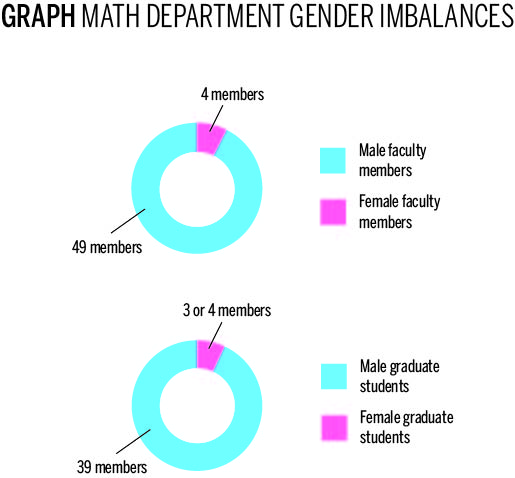
In 2013, Hee Oh GRD ’97 became the first woman in Yale’s Department of Mathematics to receive tenure. Almost five years later and following several University-wide initiatives to increase faculty diversity, Oh remains the department’s only tenured female professor.
Apart from Oh, just four of the 53 faculty members in the math department are women. None of them are currently on the tenure track. And among Yale’s 40 graduate students in math, fewer than five are women.
Seven professors and students interviewed by the News suggested that gender imbalances in the math department indicate more than just a historical underrepresentation of women in STEM. Instead, they said, the department’s lack of gender diversity stems from its inadequate efforts to build up junior faculty and from a broken supply chain starting at the undergraduate level.
Two years into the University’s $50 million, five-year faculty diversity initiative — the biggest in recent history — gender imbalances in the math department persist.
“I have seen very little indication of anything changing in the five years that I have been here, so I’m not very optimistic,” said Senia Sheydvasser GRD ’18, a graduate student in math. “The current trajectory that we have is not sustainable. That I can say with a 100 percent certainty.”
Math Department chair Igor Frenkel GRD ’80, Dean of the Faculty of Arts and Science Tamar Gendler and Deputy Dean for Diversity and Faculty Development Kathryn Lofton did not respond to requests for comment.
At a time when federal institutions, such as the National Science Foundation, are focusing on supporting young talented mathematicians, the math department at Yale is falling behind in recruiting future leaders of the field. According to two faculty members and one graduate student familiar with the department’s recruitment process, junior faculty are seldom offered tenure positions or put on the tenure track. Rather, the department has made it standard practice to tap established scholars who have already received tenure at other institutions, as was the case with Oh, who was awarded tenure at Caltech before moving to New Haven.
One faculty member, who asked to remain anonymous for fear of departmental backlash, said the math department’s expectation of hiring renowned professors is unrealistic given that the department does not rank among the top five math departments in the nation. The department’s focus on scholars who have already made names for themselves currently favors men, the professor added.
In Sheydvasser’s view, the department’s hiring strategy disadvantages well-established female scholars because they are statistically more likely than their male counterparts to have a working spouse, presenting a greater obstacle to relocation.
“They don’t really have a tenure track as I understand it,” said assistant math professor Pat Devlin, who is currently on a three-year contract. “It’s kind of like they hire you because you are already the best, or they hire you because you are disposable, and they will kick you out soon.”
In Devlin’s estimation, the department’s hiring strategy stems from a concern for its reputation, which the department likely believes would suffer if it put someone on the tenure track but ultimately decided against awarding tenure.
Based on a report by the Office of Institutional Research at Yale, three out of 16 math majors in the Class of 2014 and three out of 14 math majors in the Class of 2015 were women. And in a given class of graduate students, there is typically just one woman, according to Sheydvasser.
Catherine Lee ’20, a potential math major, said the gender imbalance in higher-level math courses has made it hard for her to form study groups. Last spring, Lee said she took a math class in which there were just five women out of a total 30 students.
Many professors in the department are “male and somewhat unapproachable,” Lee added.
“Having more women would create a better advising system,” she said. “People subconsciously drive women away from the department and the major, not necessarily intentionally, but they are not very supportive.”
Elijah Gunther ’18, a math major, said that even having three or four female students in an advanced math class is surprising. He added that in previous years, before the math peer-tutoring system was improved, there was inadequate support for students who were not confident that they were good at math or should be doing math.
“It startles me how many [female math majors] have at least one story of someone talking down to them that they do not belong here,” Sheydvasser said.
Despite the math department’s institutional inertia, faculty and student groups are mobilizing to create a more inclusive environment.
Devlin, who is currently teaching the well-known calculus and linear algebra class, MATH230, said one of his priorities is to ensure that the gender distribution during shopping period is proportional to that at the end of the course.
The Yale Undergraduate Math Society has started to hold regular Wednesday night “problem sessions,” during which students from across the math department can meet and work on problem sets together. According to Lee, this could help women in the department feel more included.
Kalina Mincheva, an assistant math professor, said she expects the recently launched Yale chapter of the Association for Women in Mathematics to ease the gender disparities by bringing female students and faculty together.
“The department has been working, but not as hard as it should be,” Oh told the News. “One has to be pretty aggressive to fix the problem.”
The problem is not unique to New Haven. Math departments at Yale’s peer institutions face similar gender disparities. Harvard has around 13 female faculty out of 50 in its math department, Princeton around 20 out of 95, Brown 5 out of 31, Stanford 6 out of 66 and MIT 5 out of 68.
Jingyi Cui | jingyi.cui@yale.edu







